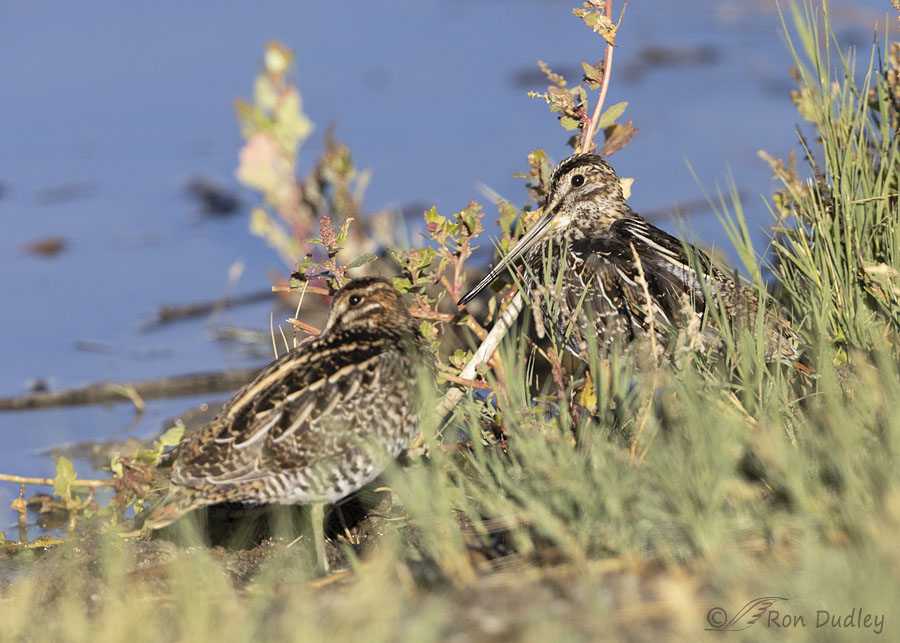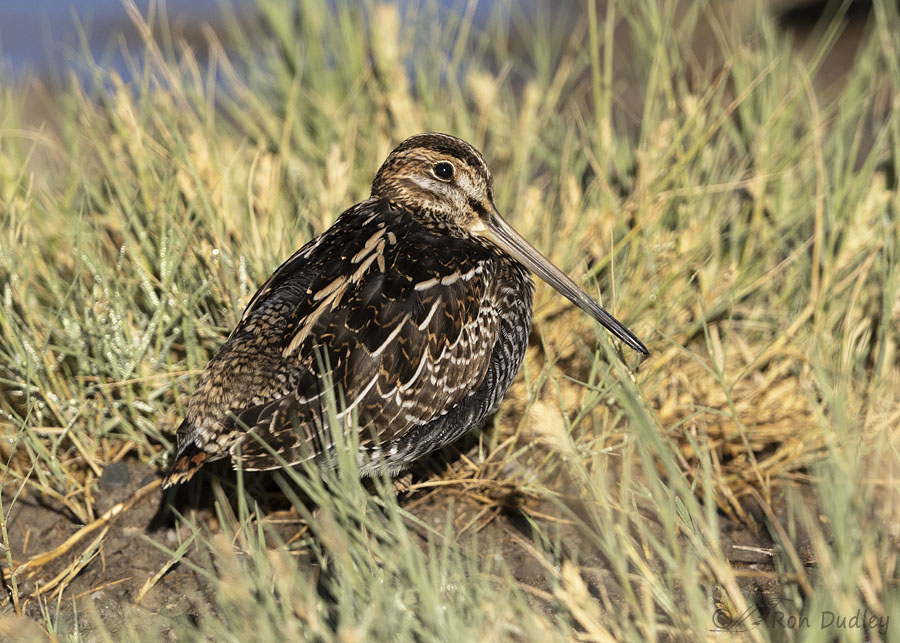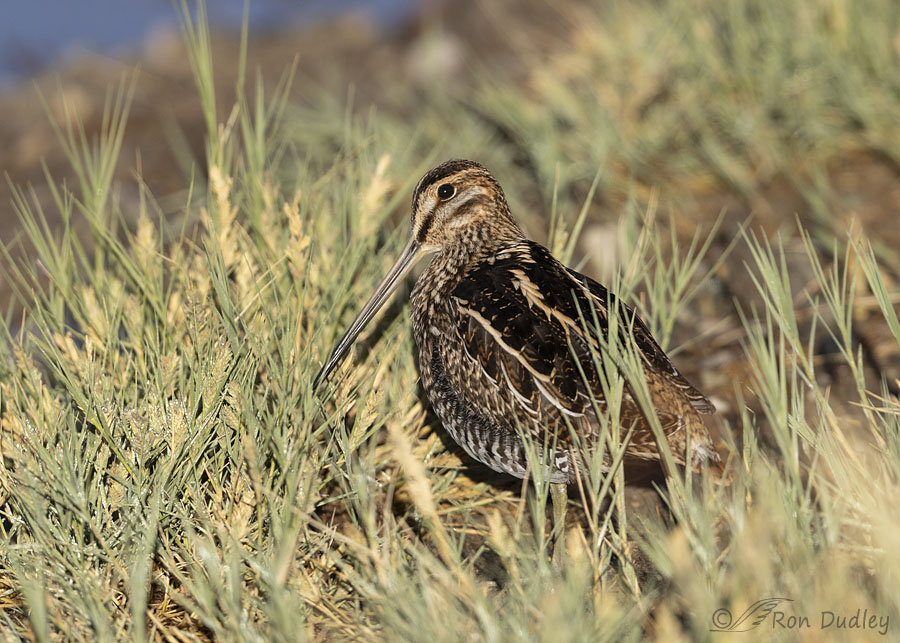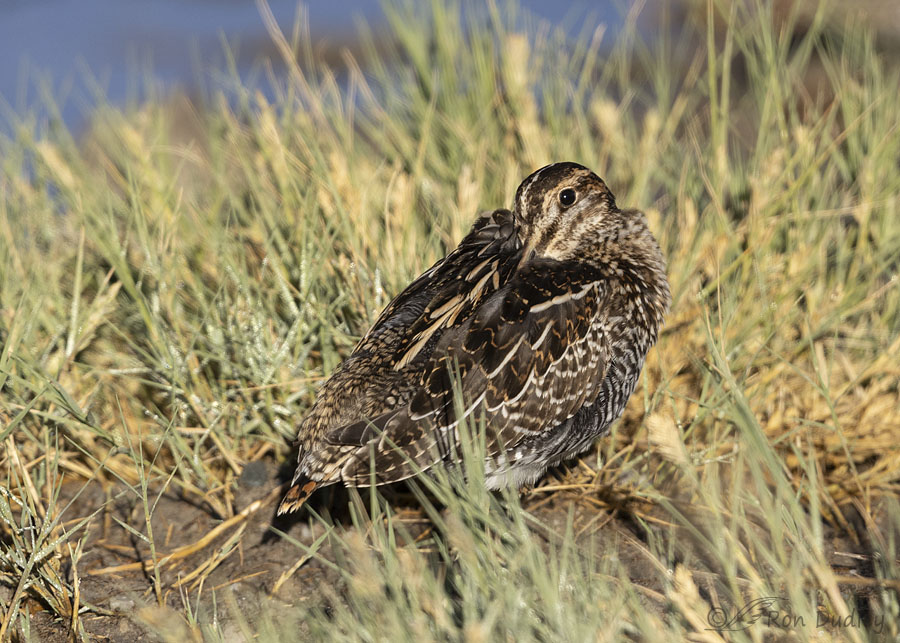Two days ago at Bear River MBR I drove slowly down a boat ramp in order to get a lower shooting angle on any birds I might find on the water. As I inched diagonally down the ramp, five Wilson’s Snipes that I hadn’t seen took off from out of the grass right in front of me and to my right. My disappointment was palpable because it had been something like four years since I’d managed to get any decent snipe photos.
So I continued to inch forward to look for birds on the water and sure enough, I flushed a sixth snipe out of the grass where the others had been, By now I was pretty disgusted with myself, so I backed up and approached the area where the snipes had been from a different angle that wouldn’t put me so close to any more that might be there.
I figured they were all gone but I sure didn’t want to scare off any more.

1/4000, f/6.3, ISO 800, Canon R5, Canon EF500mm f/4L IS II USM + 1.4 tc, not baited, set up or called in
To my surprise there were four of them left, in the grass, close to the water and very difficult to see. These two were closest to the water and to each other. I didn’t have enough depth of field to get them both sharp and there was lots of grass in front of one of them so I concentrated on the other two.
1/4000, f/6.3, ISO 800, Canon R5, Canon EF500mm f/4L IS II USM + 1.4 tc, not baited, set up or called in
I had pretty good looks at both of them. Neither one was doing much of anything but watching me but it sure was fun to get these strange little birds in my viewfinder again. Every time I see a snipe I think “Where’s your tail, little guy?”
1/4000, f/6.3, ISO 800, Canon R5, Canon EF500mm f/4L IS II USM + 1.4 tc, not baited, set up or called in
Here’s the other one.
1/4000, f/6.3, ISO 800, Canon R5, Canon EF500mm f/4L IS II USM + 1.4 tc, not baited, set up or called in
The only variation I saw in their behavior was when this one tucked ‘his’ long bill under his wing and tried to sleep. At one point I could hear chirping (for lack of a better word) coming from one of the four snipes and at first I couldn’t figure out which one it was. But then I could tell it was this bird that was chirping because I could see his feathers twitch every time he made the sound.
I had the distinct impression he was telling me to go away so he could get some shuteye. So after a couple of minutes I did.
Ron





i always love how deeply respectful you are of the birds as you enter their space/territory. I wish you could be cloned!
Other photographers can be so disrespectful of the birds, as you well know, just to get a ‘good photo’.
so appreciate you!!!!
Hello Ron. Yesterday, & today, there was a huge flock of white pelicans over Bountiful, Utah. Didn’t seem to be in a hurry to travel, just milling around. Wondered if you knew where coming from, or anything else about them. -Val Stock
Valon, could be several explanations but what you saw is far from unusual in that general area. They often circle around in groups, seemingly lazily, using thermals to gain elevation before flying to or from distant feeding grounds. They gain great elevation first so they can glide effortlessly for much of the way.
I am so glad that you saw and captured some of them. And can feel your frustration at the ones you spooked. Definitely an odd looking little bird and I echo your ‘where’s your tail?’
Thank you, EC.
I can’t help wondering, out of ALL the species of birds available,
how the Snipe was chosen by name, at least, to be the “fool’s errand”
bird to send a newbie out after ? If you or any of your posse can
answer this question, I’d love to know !
Good question, Kris. I dunno, but here’s some background from Wiki:
“A snipe hunt is a type of practical joke or fool’s errand, in existence in North America as early as the 1840s, in which an unsuspecting newcomer is duped into trying to catch an elusive, nonexistent animal called a snipe. Although snipe are an actual family of birds, a snipe hunt is a quest for an imaginary creature whose description varies.
The target of the prank is led to an outdoor spot and given instructions for catching the snipe; these often include waiting in the dark and holding an empty bag or making noises to attract the creature. The others involved in the prank then leave the newcomer alone in the woods to discover the joke. As an American rite of passage, snipe hunting is often associated with summer camps and groups such as the Boy Scouts. In France, a similar joke is called “hunting the dahut”.”
Sensational series!
Charlotte Norton
Thanks.
Glad your “snipe hunting” was successful. I can only imagine your frustration in accidentally flushing so many.
“I can only imagine your frustration in accidentally flushing so many.”
I was pretty unhappy with myself, Marty. Especially when I did it the second time.
Peculiar bird! Have never seen one so did a quick Google search. Big feet, ginormous bill and delicate tail! Odd combo yet cute!
“Peculiar bird” indeed, Kathleen. For a bunch of reasons.
Beautiful Ron! I’m inspired by your perseverance throughout all your surgeries and pain. Love Bear River, and get there when I can from Durango.
Thanks very much, Trish.
Lucky find. We have had Willets and Dowitchers so far, but I don’t think anyone has reported seeing Snipes yet. Bet that guy was glad you drove off and let him sleep.
Thanks, Everett. I’ll definitely take luck when I can get it.
I’ve never seen one tho maps indicate they are here. Definitely a different bird! Even if not doing much the shots DO tell a tale about them.
All I remember about “snipes” is upper classmen wanting to send freshmen on “snip hunts” at UM MANY years ago……..
Judy, I’ve seen them in the Centennial Vally but not on the MT farm, even though there’s a creek (crick ) there.
) there.
Ahhh, snipe hunts. The memories…
Wonderful photos, Ron. These birds are so cute. If snipes are like pet birds, ducks and chickens, they talk/sing to themselves when they tuck their bills under a wing and “nap”. I wonder if it is usually females that twitter while napping as I know that brooding moms as well as mother birds keeping their hatchlings warm will talk quietly to their young.
Thanks, Melanie. I’m not sure what the motivation was for the chirping of this one snipe.
I saw the back of one’s head one time, and you could see its eyes. They were so far to the side, it could see probably nearly 360 degrees. Strange to think of that. It would be getting two different views and its brain would be sorting all that out.
An accurate observation, Sallie. From Cornell:
“The eyes of the snipe are set remarkably far back on its head, providing full vision to both sides and a binocular overlap to the rear. This arrangement enables a bird to detect the approach of a predator while its beak is fully buried in the substrate.”
Never seen one of these in the wild. They not only sound like they are hard to spot, but much harder to get a photo. Well done.
According to the Audubon migration map, the best chance I would have in seeing one is in the marshes of the California Central Valley during Winter. I just may go on a Snipe search this winter.
The Wikipedia page says about the lain name, “The genus name gallinago is Neo-Latin for a woodcock or snipe from Latin gallina, “hen” and the suffix -ago, “resembling”. The specific delicata is Latin for “dainty”. Guess it fits.
Michael, the hardest things about photographing snipes is spotting them, if they’re there. They’re not common and they’re very hard to see in their typical habitat. Here’s what BotW says on the subject:
“This is an elusive species; the usual view of a Wilson’s Snipe is as it flushes from grass or sedges, escaping in rapid, zigzag flight while uttering a rasping scaipe.”
What an interesting-looking bird…..you’re thinking “Where’s your
tail?”, and I’m thinking “What a VERY LONG BILL you have,
my dear !” Does the snipe dig down deep for its food ?
“Does the snipe dig down deep for its food?”
Yes, Kris. They use their long bill to probe in the soil.
I’ve only seen Wilson’s Snipes twice, but each time they were equally hidden in grasses, and startled the life out of me when I came upon them. It’s neat that you got to hear that little sound — and ‘see’ it, too.
They do explode when they take off, don’t they Shoreacres. I saw a few of them take off again this morning but I wasn’t close when it happened.